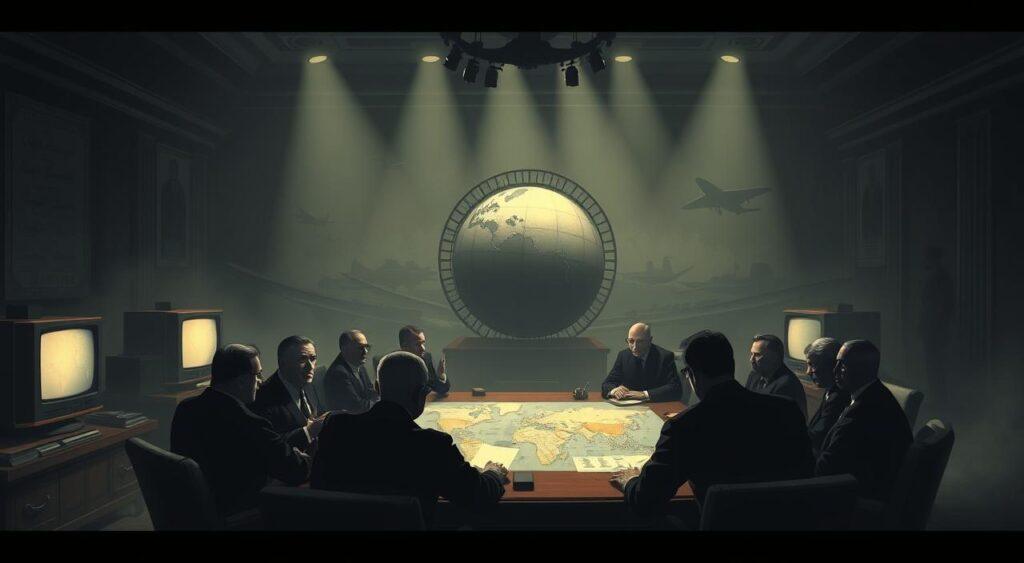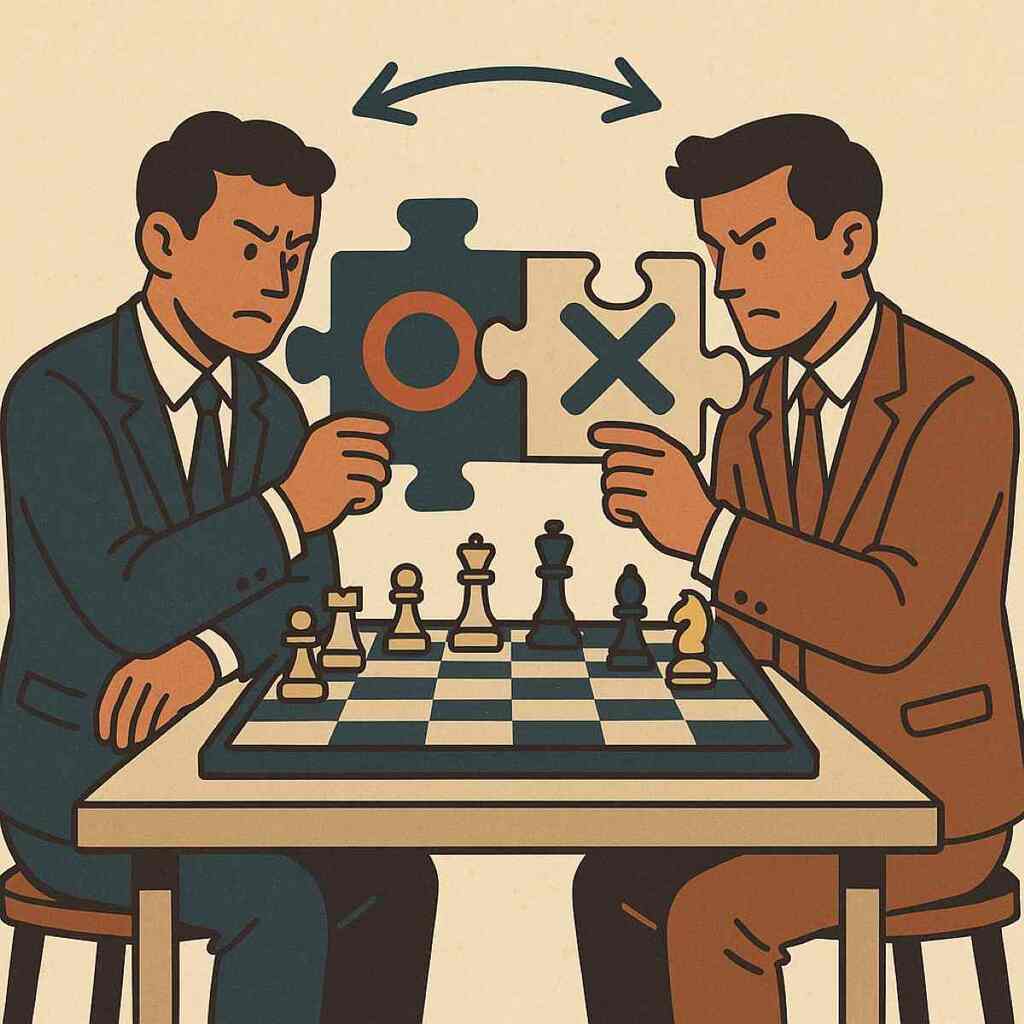The game theory mental model helps you guess how others will act when your choices depend on theirs. It’s a way to understand strategic interactions in many areas. This includes business talks and family issues, where everyone’s decisions matter.
Success isn’t just about making the right choice. It’s also about knowing what others will do. This model is based on economics, mathematics, and psychology. It shows how personal goals can lead to unexpected group actions.
The game theory mental model explains why smart people might compete, even when working together seems smarter. It also shows why trust often fails, even when it’s good for everyone. Examples include the Prisoner’s Dilemma, Nash equilibrium, and Cold War strategies.
Using this model, you’ll start to see dominant strategies and hidden motives. You’ll plan better in tough or uncertain situations. Whether leading a team, making investments, or solving policy issues, game theory helps you make better choices.
Key Takeaways
- Game theory mental model: Predicts how others’ decisions impact your success in competitive or cooperative scenarios
- Identify hidden reasons behind seemingly irrational group behavior
- Simplify complex negotiations into actionable strategies
- Apply insights across fields like economics, relationships, and career planning
- Recognize why mutual benefit doesn’t always lead to teamwork
- Shift from linear thinking to analyzing interconnected choices
Introduction to Game Theory and Its Impact
Ever faced a decision where the best option depends on someone else’s action? This strategic framework reveals how interconnected choices shape outcomes.
Let’s explore why smart decisions often require anticipating others’ moves—and how this awareness solves real-world problems.
Strategic Decision-Making Under Interdependence
A crowded highway shows us the Nash equilibrium. Here, drivers act only for themselves, not thinking about the bigger picture. This is like the Tragedy of the Commons, where everyone’s smart choice leads to a bad outcome for everyone.
Seeing these patterns helps us spot where things aren’t working well. It also shows us how we might work together better.
Consider workplace teams. If one member prioritizes personal recognition over group goals, productivity drops. Research shows 61% of people default to self-focused decisions under pressure. Recognizing this tendency helps you design better collaboration strategies.
Real-World Examples and the Prisoner’s Dilemma
Two suspects face interrogation separately. If both stay silent, they get light sentences. If one betrays the other, the betrayer walks free. But if both confess, they face harsher penalties. Here’s how it plays out:
| Your Choice | Partner’s Choice | Your Outcome |
|---|---|---|
| Stay Silent | Stay Silent | 1 Year Jail |
| Confess | Stay Silent | Freedom |
| Confess | Confess | 3 Years Jail |
Despite cooperation offering better joint results, most choose betrayal. Why? Short-term safety often overrides long-term trust. This pattern repeats in business negotiations, environmental policies, and even family dynamics. The lesson?
Sometimes, winning requires redefining what “winning” means.
Think about the Tit-for-Tat Strategy Mental Model. Game theory explains the logic behind decisions. But the Tit-for-Tat strategy shows how giving back can make cooperation last.
Understanding the Game Theory Mental Model in Strategic Situations

Why do rivals sometimes choose peace over conflict when tensions rise? The answer lies in analyzing dominant strategies—actions that remain optimal regardless of others’ moves. This approach shaped global politics during decades of superpower rivalry.
Dominant Strategies and Competitive Incentives
Every strategic scenario has key players, possible moves, and payoffs. The Cold War illustrates this perfectly. Both nations faced a critical choice: build more weapons or reduce arsenals. Though disarmament benefited everyone, building up became the default strategy.
| US Action | USSR Action | Outcome |
|---|---|---|
| Arm | Arm | Stalemate (High Cost) |
| Disarm | Arm | US Vulnerability |
| Arm | Disarm | USSR Vulnerability |
| Disarm | Disarm | Mutual Savings (Rare) |
Lessons From 20th-Century Brinkmanship
Nuclear deterrence worked because both sides understood catastrophic consequences. By stockpiling weapons, they made attack irrational—a balance still studied in conflict resolution today. This “balance of terror” paradoxically kept peace for generations.
Similar patterns emerge in business pricing wars or social media algorithms. When competitors match each other’s aggressive moves, everyone loses margin or escalates toxicity. Recognizing these traps helps you pause and seek cooperative solutions.
Game Theory Applications in Business, Economics, and Investing
Every major business decision exists in a web of competing interests. From pricing wars to supply chain negotiations, leaders constantly balance their moves against rivals’ potential responses.
This interplay defines modern markets—and separates thriving companies from those that fade.
Competitive Markets and Oligopolies in Action
Take the cola wars. Coca-Cola and Pepsi could both earn $10 million monthly by keeping prices high. But when one discounts, customers flock—forcing the other to match. The result? Shrinking profits for both. This pattern repeats in telecom, airlines, and tech.
Warren Buffett’s textile ventures reveal a darker side. When factories invested in cost-cutting tech, competitors followed. Prices dropped industry-wide, erasing gains. What seemed smart individually became destructive collectively—a trap strategic frameworks in economics help avoid.
Case Studies: Amazon’s Pricing Strategy and the Investment Dilemma
Amazon’s 2010s playbook changed retail forever. By accepting slim margins, they pressured rivals like Borders into bankruptcy. Their strategy? Sacrifice immediate profits to dominate markets long-term.
Today, 70% of economic models use these principles. Vaccine distribution plans and AI algorithms now apply the same ideas. Investors who grasp these patterns spot risks earlier—like how a competitor’s factory expansion might nullify your cost advantage.
The lesson? Success often hinges on predicting others’ moves before they happen. Those who master this art shape markets rather than react to them.
The Barbell Strategy Mental Model is also relevant. It differs from game theory by focusing on managing risk. This approach helps reduce losses in unpredictable markets.
Practical Decision-Making and Real-World Examples

Picture your morning commute turning into a standstill because three drivers refused to take turns. Daily choices—from merging lanes to allocating budgets—reveal how self-focused actions create systemic breakdowns.
Let’s explore patterns where individual logic clashes with group success.
Game Theory Mental Model: Traffic Gridlock as a Strategy
The “dead-circle” intersection shows how rushed decisions backfire. When drivers accelerate to block others, they often trap themselves.
Studies show 73% of urban congestion stems from competitive lane changes rather than pure volume.
| Driver’s Action | Others’ Actions | Collective Outcome |
|---|---|---|
| Rush Ahead | Same Behavior | 30-Minute Delay |
| Yield | Alternate Turns | 5-Minute Flow |
| Block Merging | Retaliatory Honking | Road Rage Incident |
This mirrors workplace dynamics. Teams arguing over credit often miss deadlines—a lose-lose situation. Recognizing these traps helps you pause before reacting impulsively.
This phenomenon echoes the Tragedy of the Commons Mental Model. It shows how individual actions can lead to problems for everyone. This is true in shared-resource environments like traffic systems or ecological management.
Beyond Roads: Systemic Patterns in Daily Life
Consider department budget battles. Marketing and sales might hoard resources, fearing shortages. But shared data often reveals overlapping needs—saving both time and funds. Frameworks from economics help reframe these standoffs.
Stock traders face similar dilemmas. Panic selling during dips worsens losses for everyone. Yet calm coordination stabilizes markets. The key? Replace fear-driven reactions with structured collaboration.
These big ideas apply anywhere group choices collide. Next time you’re stuck—literally or metaphorically—ask: “Could cooperation unlock what competition can’t?”
Conclusion
The game theory mental model teaches us that in many scenarios, success hinges not on acting in isolation but in anticipating and adapting to others’ behavior. From Cold War diplomacy to corporate strategy, these frameworks uncover invisible patterns in human interaction.
By integrating insights from economics, psychology, and behavioral science, this model turns chaos into clarity. Want to apply this mental model in real-world settings?
Explore complementary concepts like the Tit-for-Tat Strategy, Signaling Theory, and the Dopamine Feedback Loop to deepen your understanding of strategic decision-making.
Ask yourself: Does this challenge require outsmarting opponents or aligning interests? Mastery comes not from rigid formulas, but practicing flexible thinking across life’s ever-changing board.


